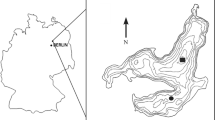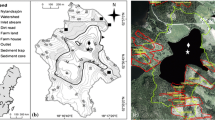Abstract
The absence of quantitative comparisons of sediment trap-collected zooplankton (TCZ) and plankton net-collected zooplankton (NCZ) prevents the effective use of TCZ for ecological studies. We compared 24 TCZ time-series at 200 m with 19 vertical NCZ casts and recorded various environmental variables in Franklin Bay, Canadian Arctic during 2003–2004. While 30 taxonomic groups were commonly found in both the TCZ and NCZ assemblages, their taxonomic composition and seasonal variation differed. Based on the multiple regression analysis, we divided zooplankton taxa into three groups; Group 1: it was significantly correlated with NCZ abundance, Group 2: it was significantly correlated with environmental variables but not with NCZ abundance, and Group 3: no significant correlations were found. Pteropods (mostly Limacina helicina) and two copepods (Heterorhabdus norvegicus and Metridia longa) were found in Group 1, suggesting that their entrapment activity were relatively constant throughout the year, and therefore their NCZ abundance can be estimated from that of TCZ using the trap settings in this study. Conversely, in Group 2, Calanus hyperboreus had no significant relationship with the NCZ abundance (C. hyperboreus). This is likely the result of a winter peak in TCZ abundance during their reproductive season; the co-occurrence of high suspended particulate organic matter with low C/N ratio around the trap probably indicated the presence of C. hyperboreus eggs and nauplii. Therefore, monitoring interannual changes in C. hyperboreus reproductive succession by TCZ abundance might be possible in the future studies. In conclusion, Group 1 taxa are potential candidates for ecological monitoring using TCZs.


Similar content being viewed by others
References
Almogi-Labin A, Hemleben C, Deuser WG (1988) Seasonal variation in the flux of euthecosomatous pteropods collected in deep sediment trap in the Sargasso Sea. Deep-Sea Res 35:441–464
Arndt CE, Fernandez-Leborans G, Seuthe L, Berge J, Gulliksen B (2005) Ciliated epibionts on the Arctic sympagic amphipod Gammarus wilkitzkii as indicators for sympago–benthic coupling. Mar Biol 147:643–652
Auel H, Hagen W (2002) Mesozooplankton community structure, abundance and biomass in the central Arctic Ocean. Mar Biol 140:1013–1021
Auel H, Klages M, Werner I (2003) Respiration and lipid content of the Arctic copepod Calanus hyperboreus overwintering 1 m above the seafloor at 2,300 m water depth in the Fram Strait. Mar Biol 143:275–282
Batten SD, Welch DW (2004) Changes in oceanic zooplankton populations in the North-east Pacific associated with the possible climatic regime shift of 1998/1999. Deep-Sea Res II 51:863–873
Brodeur RD, Ware DM (1992) Long-term variability in zooplankton biomass in the subarctic Pacific Ocean. Fish Oceanogr 1:32–38
Carmack EC, MacDonald RW (2002) Oceanography of the Canadian Shelf of the Beaufort Sea: a setting for marine life. Arctic 55:29–45
Conover RJ, Huntley M (1991) Copepods in ice-covered seas—distribution, adaptations to seasonally limited food, metabolism, growth patterns and life cycle strategies in polar seas. J Mar Syst 2:1–41
Darnis G, Fortier L (2012) Zooplankton respiration and the export of carbon at depth in the Amundsen Gulf (Arctic Ocean). J Geophys Res 117:C04013. doi:10.1029/2011JC007374
Darnis G, Fortier L (2014) Temperature, food and the seasonal vertical migration of key arctic copepods in the thermally stratified Amundsen Gulf (Beaufort Sea, Arctic Ocean). J Plankton Res. doi:10.1093/plankt/fbu035
Darnis G, Barber DG, Fortier L (2008) Sea ice and the onshore-off- shore gradient in pre-winter zooplankton assemblages in south-eastern Beaufort Sea. J Mar Syst 74:994–1011
Darnis G, Robert D, Pomerleau C, Link H, Archambault P, Nelson RJ, Geoffroy M, Tremblay JÉ, Lovejoy C, Ferguson SH, Hunt BPV, Fortier L (2012) Current state and trends in Canadian Arctic marine ecosystems: II. Hterotorophic food web, pelagic–benthic coupling, and biodiversity. Clim Change. doi:10.1007/s10584-012-0483-8
Dawson JK (1978) Vertical distribution of Calanus hyperboreus in the central Arctic Ocean. Limnol Oceanogr 23:950–957
Fabry VJ, Seibel BA, Feely RA, Orr JC (2008) Impacts of ocean acidification on marine fauna and ecosystem processes. ICES J Mar Sci 65:414–432
Falk-Petersen S, Leu E, Berge J, Kwasniewski S, Nygård H, Røstad A, Keskinen E, Thormar J, von Quillfeldt C, Wold A, Gulliksen B (2008) Vertical migration in high Arctic waters during autumn 2004. Deep-Sea Res II 55:2275–2284
Forbes JR, Macdonald RW, Carmack EC, Iseki K, O’Brien MC (1992) Zooplankton retained in sequential sediment traps along the Beaufort Sea shelf break during winter. Can J Fish Aquat Sci 49:663–670
Forest A, Sampei M, Makabe R, Sasaki H, Barber DG, Gratton Y, Wassmann P, Fortier L (2008) The annual cycle of particulate organic carbon export in Franklin Bay (Canadian Arctic): environmental control and food web implications. J Geophys Res 113:C03S05
Fortier M, Fortier L, Hattori H, Saito H, Legendre L (2001) Visual predators and the diel vertical migration of copepods under Arctic Sea ice during the midnight sun. J Plankton Res 23:1263–1278
Gallienne CP, Robins DB (2001) Is Oithona the most important copepod in the world’s oceans? J Plankton Res 23:1421–1432
Gislason A, Astthorsson OS (1992) Zooplankton collected by sediment trap moored in deep water south of Iceland. Sarsia 77:219–224
Harbison GR, Gilmer RW (1986) Effects of animal behavior on sediment trap collections: implications for the calculation of aragonite fluxes. Deep-Sea Res 33:1017–1024
Hays GC (1995) Ontogenetic and seasonal variation in the diel vertical migration of the copepod Metridia lucens and Metridia longa. Limnol Oceanogr 40:1461–1465
Hirche H-J (1997) Life cycle of the copepod Calanus hyperboreus in the Greenland Sea. Mar Biol 128:607–618
Hosie GW, Fukuchi M, Kawaguchi S (2003) Development of the Southern Ocean Continuous Plankton Recorder survey. Prog Oceanogr 58:263–283
Kiørboe T, Saiz E (1995) Planktivorous feeding in calm and turbulent environments, with emphasis on copepods. Mar Ecol Prog Ser 122:135–145
Kobayashi HA (1974) Growth cycle and related vertical distribution of the thecosomatous pteropod Spiratella (Limacina) helicina in the central Arctic Ocean. Mar Biol 26:295–301
Kosobokova K, Hirche H-J (2009) Biomass of zooplankton in the eastern Arctic Ocean—a base line study. Prog Oceanogr 82:265–280
Kwasniewski S, Gluchowska M, Jakubas D, Wojczulanis-Jakubas K, Walkusz W, Karnovsky N, Blachowiak-Samolyk K, Cisek M, Stempniewicz L (2010) The impact of different hydrographic conditions and zooplankton communities on provisioning Little Auks along the West coast of Spitsbergen. Prog Oceanogr 87:72–82
Mackas DL, Batten SD, Trudel M (2007) Effects on zooplankton of a warming ocean: recent evidence from the Northeast Pacific. Prog Oceanogr 75:223–252
Makabe R, Hattori H, Sampei M, Ota Y, Fukuchi M, Fortier L, Sasaki H (2010) Regional and seasonal variability of zooplankton collected using sediment traps in the southeastern Beaufort Sea, Canadian Arctic. Polar Biol 33:257–270
Matsuno K, Yamaguchi A, Fujiwara A, Onodera J, Watanabe E, Imai I, Chiba S, Harada N, Kikuchi T (2014) Seasonal changes in mesozooplankton swimmers collected by sediment trap moored at a single station on the Northwind Abyssal Plain in the western Arctic Ocean. J Plankton Res 36:490–502
Möllmann C, Kornilovs G, Sidrevics L (2000) Long-term dynamics of main mesozooplankton species in the central Baltic Sea. J Plankton Res 22:2015–2038
Orr JC, Fabry VJ, Aumont O et al (2005) Anthropogenic ocean acidification over the twenty-first century and its impact on calcifying organisms. Nature 437:681–686
Ota Y, Hattori H, Makabe R, Sampei M, Tanimura A, Sasaki H (2008) Seasonal changes in nauplii and adults of Calanus hyperboreus (Copepoda) captured in sediment traps, Amundsen Gulf, Canadian Arctic. Polar Sci 2:215–222
Peterson W, Dam HG (1990) The influence of copepod ‘swimmers’ on pigment fluxes in brine-filled vs. ambient seawater-filled sediment traps. Limnol Oceanogr 35:448–455
Purcell JE (2009) Extension of jellyfish and ctenophore trophic ecology to large-scale research. Hydrobiologia 616:23–50
Richardson AJ, Schoeman DS (2004) Climate impact on plankton ecosystems in the Northeast Atlantic. Science 305:1609–1612
Sampei M, Sasaki H, Hattori H, Forest A, Fortier L (2009a) Significant contribution of passively sinking copepods to the downward export flux in Arctic waters. Limnol Oceanogr 54:1894–1900
Sampei M, Forest A, Sasaki H, Hattori H, Makabe R, Fukuchi M, Fortier L (2009b) Attenuation of the vertical flux of copepod fecal pellets under Arctic sea ice: evidence for an active detrital food web in winter. Polar Biol 32:225–232
Sampei M, Sasaki H, Makabe R, Forest A, Hattori H, Tremblay J-É, Gratton Y, Fukuchi M, Fortier L (2011) Production and retention of biogenic matter in the southeast Beaufort Sea during 2003–2004: insights from annual vertical particle fluxes of organic carbon and biogenic silica. Polar Biol 34:501–511
Sampei M, Sasaki H, Forest A, Fortier L (2012) A substantial export flux of particulate organic carbon linked to sinking dead copepods during winter 2007–2008 in the Amundsen Gulf (southeastern Beaufort Sea, Arctic Ocean). Limnol Oceanogr 57:90–96
Seiler D, Brandt A (1997) Seasonal occurrence of planktic Crustacea in sediment trap samples at three depth horizons in the Greenland Sea. Polar Biol 17:337–349
Seuthe L, Darnis G, Wexels Riser C, Wassmann P, Fortier L (2007) Winter-spring feeding and metabolism of Arctic copepods: insights from faecal pellet production and respiration measurements in the southeastern Beaufort Sea. Polar Biol 30:427–436
Steele DH, Steele VJ (1974) The biology of Gammarus (Crustacea, Amphipoda) in the northwestern Atlantic VIII. Geographic distribution of the northern species. Can J Zool 52:1115–1120
Walkusz W, Majewski A, Reist JD (2013) Distribution and diet of the bottom dwelling Arctic cod in the Canadian Beaufort Sea. J Mar Syst 127:65–75
Williams R, Robins D (1981) Seasonal variability in abundance and vertical distribution of Parathemisto gaudichaudi (Amphipoda: Hyperiidea) in the north east Atlantic Ocean. Mar Ecol Prog Ser 4:289–298
Willis K, Cottier F, Kwasniewski S, Wold A, Falk-Petersen S (2006) The influence of advection on zooplankton community composition in an Arctic fjord (Kongsfjorden, Svalbard). J Mar Syst 61:39–54
Willis KJ, Cottier FR, Kwasniewski S (2008) Impact of warm water advection on the winter zooplankton community in an Arctic fjord. Polar Biol 31:475–481
Yamaguchi A, Ikeda T (2000) Vertical distribution, life cycle and body allometry of two oceanic calanoid copepods (Pleuromamma scutullata and Heterorhabdus tanneri) in the Oyashio region, western North Pacific Ocean. J Plankton Res 22:29–46
Acknowledgments
We are extremely grateful for the extensive financial and management support given by Professor Mitsuo Fukuchi of the National Institute of Polar Research. We thank the officers and crew of the CCGS Amundsen for their help during the CASES 2003–2004 expedition. This study was supported by a Grant-in-Aid from the Japan Society for the Promotion of Science to H. Sasaki (No. 16510010), and by a grant from the Natural Science and Engineering Research Council of Canada to L. Fortier. This is a contribution to the programs Québec-Océan, CASES, and the Canada Research Chair on the response of Arctic marine ecosystems to climate warming.
Author information
Authors and Affiliations
Corresponding author
Electronic supplementary material
Below is the link to the electronic supplementary material.
Rights and permissions
About this article
Cite this article
Makabe, R., Hattori, H., Sampei, M. et al. Can sediment trap-collected zooplankton be used for ecological studies?. Polar Biol 39, 2335–2346 (2016). https://doi.org/10.1007/s00300-016-1900-7
Received:
Revised:
Accepted:
Published:
Issue Date:
DOI: https://doi.org/10.1007/s00300-016-1900-7




